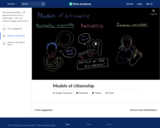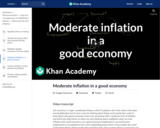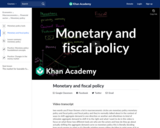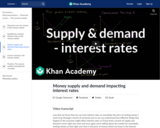
Comparing different models of what it means to be a good citizen. Created by Kimberly Kutz.
- Subject:
- Political Science
- Social Science
- Material Type:
- Lesson
- Provider:
- Khan Academy
- Provider Set:
- Khan Academy
- Author:
- Kim Kutz
- Date Added:
- 07/16/2021

Comparing different models of what it means to be a good citizen. Created by Kimberly Kutz.

Moderate amounts of inflation are common in healthy economies, so some inflation may actually be a good sign. Learn why in this video. Created by Sal Khan.

Basic mechanics of monetary and fiscal policy. Created by Sal Khan.

Monetary policy is the use of the money supply to affect key macroeconomic variables, such as real GDP. This video focuses on how a central bank can use open market operations and reserve requirements to enact monetary policy to close output gaps.

Most people assume that the government prints money, and that is how money is created. That is not entirely true. Watch this video to find out the role that banks play in the creation of the money supply.

In this video, learn about the two measures of money that are part of the money supply: M1 and M2. Topics include what is included in M1 and M2 and the monetary base (which is sometimes called M0). Created by Sal Khan.

Examples showing how various factors can affect interest rates. Created by Sal Khan.

Learn about the key differences between the two extremes of competition: monopolies and perfect competition.

In this video we explore why it is hard for a monopolistic competitor to make economic profit in the long run. Created by Sal Khan.

A monopolist might be pretty happy about its extraordinary profits, but these come at a cost for society. In this video we explore the welfare implications of a monopoly market. Created by Sal Khan.

A monopolist's marginal revenue curve is always less than its demand curve. We explore why using a numerical example in this video. Created by Sal Khan.

In this video we explore how a monopolist decides on the best quantity to produce and the price to charge for that quantity. Created by Sal Khan.

Price discrimination is charging each consumer their entire willingness to pay. What if a monopolist can charge each buyer their entire willingness to pay? Learn about the effect of perfect price discrimination on output and deadweight loss in this video.

We've learned in previous lessons that a price control decreases quantity and efficiency, but is that always the case? Learn about the surprising effect of a minimum wage on a monopsonistic labor market in this video.

In prep for the 250th anniversary of US founding, this toolbox of resources in history, civics, literature, arts, and culture to tell teh story of our ongoing quest to become a more just, inclusive, and sustainable society.

Public vs. Private Equity. Why people buy equity to begin with. Created by Sal Khan.

In this video we expand our analysis of the prisoners' dilemma to better understand the concept and definition of a Nash Equilibrium. Created by Sal Khan.

What happens to equity when the value of the assets increase or decrease? Created by Sal Khan.

Looking a bit deeper at why elasticity changes despite having a linear demand curve. Created by Sal Khan.

If you make some cloth and someone uses that cloth to produce something else, how does that show up in the calculation of GDP? In this video, learn how GDP deals with intermediate goods. Created by Sal Khan.